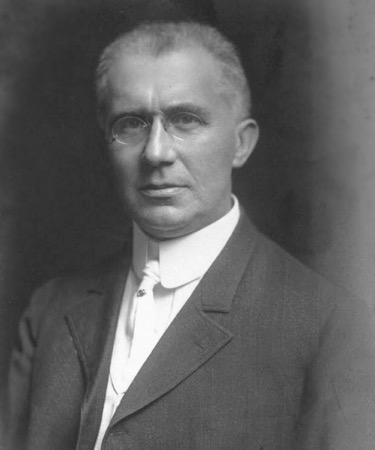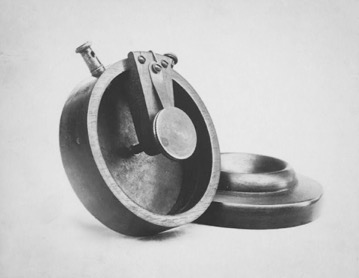Mar 04, 2014 02:20 PM Filed in:
History
Emile Berliner
The Birth of Recording
Dreamers in the 19th century seemed to be driven by the need to capture things. Animals were captured and put into the first American zoos In Philadelphia, Chicago, Cincinnati, and New York. Light was captured by Joseph Niépce and Louis Daguerre in France. And sound was captured in France by Édouard-Léon Scott de Martinville. Scott? De Martin--who? I always thought Thomas Edison had been the first. He was the first to record
and play back sound, an important distinction. Scott's phonautograph recorded sounds as early as 1854, 24 years before Edison. But there was one problem, Scott didn't think about playing them back. They were simple lines drawn on a sheet of paper, not a physical etching into tin foil like Edison's invention.
Explore the first sounds here. 
Carbon Microphone
Other inventions started to pour out of laboratories, like the telephone, the electric generator, and the light bulb. While these men were rightly made famous, it's usually the people who improve the invention that push it into everyday use. Take Emile Berliner, a German-born Jewish immigrant that came to the U.S. in 1870 at the tender age of 19. By the time he was in his late 20's, he was filing patents for telephone-related improvements. His carbon microphone got the attention of Alexander Bell and soon after was working for him. Although the carbon microphone was also independently invented by Bell and David Hughes, Berliner's vastly improved upon Bell's with much higher output. The carbon microphone became a staple of telephony and was used well into the 1980's. Early radio broadcasters used them as well. You can even still buy one new, the Shure 104c, to interface with legacy equipment.

Emile Berliner with his Gramophone But Berliner is probably best known as the inventor of the Gramophone. Edison's recordings were done on a cylinder. Berliner put his on a disc. The disc would become one of the most common devices in the twentieth century to store data, such as the record, the CD, the DVD, and the hard drive. But Berliner wasn't done with audio inventions yet. He also created the acoustic tile that recording studios, radio and TV stations, and performance halls rely on today.
Emile Berliner would also invent a new type of loom, floor covering, and an early helicopter utilizing a lightweight rotary engine. Whew!
Like other inventors of his magnitude, he was wrapped up in legal battles for many years. The Berliner Gramophone Company was forced to operate out of Canada while his former collaborator started the Victor Talking Machine Company using everything he learned from Berliner. His carbon microphone patent was trumped by Bell in court on a technicality. He was a philanthropist and advocate of public health and sanitation issues, especially when it came to children. He was also deeply involved with Zionism, writing several articles for newspapers and journals.
Berliner made many contributions to recording, especially the microphone. His improvement leapfrogged any existing technology and allowed telephone service to be quickly extended long distances because of the greatly increased output. This high-output microphone would also allow early radio experimenters to transmit the voice further. Thank you Mr. Berliner.
Did You Know?
There are many similarities between Thomas Edison's first recordings and Édouard-Léon Scott de Martinsville's early recordings. Both used a bell to capture sound waves that vibrated a stylus. This stylus rested on a rotating cylinder. Scott's etched waves into soot-stained paper. Edison's etched waves into tin foil. Edison's could be considered "mechanical," while Scott's "optical."
Early filmmakers desperately tried to include sound with film, but the awkward technology of record discs made it difficult to synchronize the two. The first commercially successful "talkies" used optical sound. Optical sound exposed film to a light that pulsed with the sound vibrations. As the film passed in front of the light, wavy lines are exposed on the edges just inside the sprockets. Much like recording sound separately from film/video today, on-set recordists relied on audible and visual slates to begin each scene. Mechanically stable motors to run the optical film recorders were vital so that sound and picture would later synchronize without lag.
Since the 1990's, many films have been distributed with optical digital tracks, such as Dolby Digital and SDDS. Later some also included optical synchronization pulses that would allow digital discs containing digital surround tracks to synchronize with the film for even clearer sound.
Tech Notes
When trying to play back Édouard-Léon Scott de Martinsville's early recordings, researchers used a technology originally made for particle generators. As they had previously done with antique cylinder and discs, they generated digital maps of the surface without actually touching it. They would use image analysis to reconstruct the audio with the added benefit of reducing noise. They first approached Scott's recordings like any other mechanical recording, by decoding the wavy lines as though they were mechanical record grooves. This didn't work, as the lines seemed malformed. But by approaching the recordings as if they were optically recorded, they were successful.
Early experiments by Scott had no reference to what speed the cylinder was rotating. These recordings are thus far unrecoverable. But Scott's later recordings included a 250 Hz tuning fork trace that can be used as a calibration aid.
This method of using a set frequency for calibration would enable the first "talkies" to be produced. Film cameras and optical, and later magnetic, sound recorders both used a set frequency for playback motors to operate at. We use it today with digital recording technology with sample rates and word clocks.
Neil Kesterson






